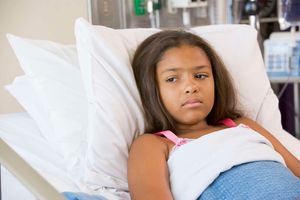Understanding childhood cancers: Preliminary notes

What you need to know:
- Once cancer has been diagnosed, it's important for parents to seek help from a medical center that specialises in pediatric oncology such as the Kenyatta National Hospital or the Moi Teaching and Referral Hospital.
- The cost of medicines for the management of childhood cancer is almost 40 percent of the treatment cost.
- A child with leukemia may have a strong fever, fatigue, cough, and infections. Further symptoms may include quick and easy bleeding or bruising, frequent gasping for air, swelling of the abdomen, underarms, neck, and groin, seizures, poor appetite, body imbalance, rashes, and gum problems.
In February 2020, Brayden was diagnosed with aplastic anaemia, a condition in which the body stops producing enough new blood cells due to bone marrow damage. The consultant pediatrician, haematologist, and oncologist Dr. Nyambura Kariuki told Brayden’s parents that they would have to seek a bone marrow transplant outside the country because the procedure could not be done locally. For the next year, Brayden was in and out of Kenyatta National Hospital where he underwent red blood cell and platelets transfusion, as his parents struggled to raise funds.
Brayden’s treatment at a hospital in India would cost at least Sh. 5 million. His parents appealed for help and moved by the little boy’s zeal to live, Kenyans contributed the amount. In April 2021, Brayden and his family traveled to India for his treatment. Four months later, in August 2021, Brayden succumbed while undergoing treatment. He was seven years old.
Little Brayden was one of many children fighting against numerous types of cancers at a very tender age. According to general physician Dr. Martin Muchembe, leukemia is the most common type of cancer in children. This cancer is also known as cancer of the white blood cells. Other types of childhood cancers include brain cancer and lymphoma. Children between ages of ten and eighteen are at a higher risk of developing bone cancer.
Cancer occurs when cells develop out of control, and in abnormal sizes and shapes. These cells break their boundaries and destroy the neighbouring healthy cells, leading to cancer spreading to other organs and tissues. “In leukemia, the abnormal white cells get into the bloodstream where they completely engulf the existing healthy cells,” says Dr. Muchembe. As the cancer cells grow, they demand more and more of the baby's nutrition and consequently weaken the baby.
Causes, Symptoms, and Diagnosis
In most cases, childhood cancers are caused by non-inherited mutations (or changes) in the genes of growing cells. Children who have had chemotherapy or radiation treatment for prior cancer episodes may have an increased risk of developing cancer again.
A doctor might spot early symptoms of cancer during regular pediatric checkups. However, symptoms such as fever, swollen glands, frequent infections, anaemia, or bruises may be misleading, causing further delay in diagnosis. A child with leukemia may have a strong fever, fatigue, cough, and infections. Further symptoms may include quick and easy bleeding or bruising, frequent gasping for air, swelling of the abdomen, underarms, neck, and groin, seizures, poor appetite, body imbalance, rashes, and gum problems. According to Dr. Muchembe, a diagnosis can be administered through examination and elimination of possible ailments as per all the symptoms presented at the hospital, and the previous health history of the child and parents. Unlike in adults, childhood cancers are usually not linked to lifestyle or environmental risk factors. About five percent of childhood cancers are passed from parent to child. “It is worth noting that most childhood cancers are not caused by inherited DNA changes but by DNA changes that occur early in the child’s life. In some cases, before the child is born,” says Dr. Muchembe. Whenever a cell divides into two new cells, it automatically copies its DNA. This division and copying process is not always perfect.
Treatment
Common treatments for childhood cancers include surgery, chemotherapy, stem cell transplant, immunotherapy, and radiation therapy. In most cases, proper diagnosis and treatment of childhood cancers take time. In some cases, the curative mode of treatment may not be locally available, putting more hurdles on the path to a child’s recovery. But lack of proper diagnosis is the biggest challenge. According to Dr. Muchembe, the failure to have the child diagnosed early enough means that the cancer is discovered when it is at an advanced stage which makes treatment harder.
Once cancer has been diagnosed, it's important for parents to seek help from a medical center that specialises in pediatric oncology such as the Kenyatta National Hospital or the Moi Teaching and Referral Hospital.
Treatment of cancer in children usually involves phases: Induction, intensification, and maintenance. Dr. Muchembe says that intensive treatment such as chemotherapy may require the child to be hospitalised for a period of about one month.
According to a 2021 research presentation by Professor Jessie Githanga, a consulting oncologist at the Kenyatta National Hospital, the cost of medicines for the management of childhood cancer is almost 40 percent of the treatment cost. This has led to Kenya losing 8 out of every 10 children under cancer treatment. As of 2021, the cost per new childhood cancer diagnosis stands at Sh. 3.4 million. This is 10 times higher than other countries such as Zimbabwe.
Types of treatment that
Surgery: This is done to remove cancerous cells or tumours. It is mostly done in combination with chemotherapy and radiation. Surgery works well on children with solid tumours that are yet to start spreading to other parts of the body.
Chemotherapy: Entails the use of medicine to kill cancerous cells. During treatment, chemotherapy can be administered to children intravenously – through the vein – or orally – by mouth, or via spinal fluid in extreme cases. Duration of chemotherapy often depends on the stage of cancer, the drugs being administered, and the child’s immune response. For example, a child may receive daily, weekly, or monthly chemotherapy treatments. In most cases, chemotherapy will be administered over a period of between 4 months and 2 years, with intervals that allow the child’s body to rest and recover.
Bone marrow transplant: This treatment process is carried out if a child has a type of cancer that affects the function of blood cells, for example, aplastic anaemia.
Radiation: This is one of the most common forms of treatment for childhood cancers. It involves the use of radiant energy to kill cancerous cells. A child who receives radiation therapy is treated with a stream of high-energy particles or waves that destroy or damage cancer cells.
Possible treatment side effects
Medications used in cancer treatment may have both short and long-term effects on your child. Short-term effects may include nausea, vomiting, hair loss, fatigue, anemia, abnormal bleeding, increased risk of infection due to destruction of the bone marrow, bladder inflammation and bleeding into the urine, hearing loss, liver damage, and heart and skin problems. Longer-term effects can include infertility, growth problems, organ damage, or increased risk of developing other cancers.
Quick Takeaway
There are certain risk factors that increase the chances of a child getting cancer. These include:
- Genetically inherited disorders such as Down Syndrome.
- Excessive suppression of the immune system during organ transplant.
- Problems with the immune system that are genetically inherited, for example, ataxia.
- Excessive exposure to radiation, chemotherapy, or paint chemicals.



